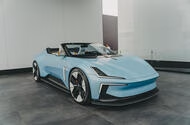Why Has Polestar Delayed the Launch of the Polestar 6 Roadster?
If you’ve been following Polestar’s journey, you might have noticed a shift in their priorities. The much-anticipated Polestar 6 roadster, which had enthusiasts buzzing, is now on pause. But why? The answer is simple: Polestar is laser-focused on models that promise broader appeal and higher sales volumes. In a rapidly evolving electric vehicle (EV) market, brands need to be nimble, and Polestar is making some strategic moves.
The company’s CEO, Michael Lohscheller, recently shared that their immediate attention is on launching the Polestar 7 crossover and developing a next-generation Polestar 2. These aren’t just any cars—they’re the backbone of Polestar’s plan to grow its presence, especially in Europe, where over 75% of its vehicles are sold. The UK, in particular, stands out as their single largest market. So, while the Polestar 6 isn’t gone for good, it’s taking a back seat while the brand builds momentum with models that can reach more drivers.
What’s Driving Polestar’s Focus on the 7 Crossover and Next-Gen 2?
Let’s face it: the compact SUV segment is booming. Polestar’s decision to prioritize the 7 crossover isn’t just a hunch—it’s a calculated response to market demand. Compact SUVs are dominating European roads, and Polestar wants a bigger slice of that pie. The Polestar 7 is set to be their most accessible model yet, both in terms of price and appeal. Lohscheller is betting that this new SUV will not only boost sales but also attract a younger, more diverse customer base.
Meanwhile, the Polestar 2 has been the brand’s runaway success. It’s the car that put Polestar on the map for many drivers. Now, the company is investing heavily in its successor, aiming to keep that momentum going. Both the 7 and the next-gen 2 are crucial for Polestar’s growth, especially as the company transitions to a more traditional retail model. This means more cars in showrooms, more customers behind the wheel, and a stronger presence in key markets.
How Is Polestar Planning to Stand Out in a Crowded EV Market?
Competition in the EV world is fierce. Every brand is vying for attention, and standing out is no small feat. Polestar’s strategy? Double down on design and driving experience, while staying true to its roots as a pure EV brand.
Lohscheller has hinted that the Polestar 7 will break away from the brand’s current design language. Expect something that feels familiar in the SUV world, but with a twist—unique enough to catch your eye, yet practical for everyday life. The goal is to blend Polestar’s signature driving dynamics and chassis tuning with a look that’s both fresh and unmistakably Polestar.
But it’s not just about looks. Sustainability is at the heart of Polestar’s mission. The company is committed to building cars that are as green as they are fun to drive. This means innovative materials, efficient production, and a relentless focus on reducing the brand’s carbon footprint. It’s a smart move, given that a recent Deloitte study found that 55% of global consumers consider sustainability an important factor when buying a car.
Who Is Polestar Trying to Reach With Its New Models?
Polestar’s customer base has, so far, skewed heavily male and performance-oriented. Lohscheller is candid about wanting to change that. The Polestar 7, with its compact size and approachable design, is aimed squarely at younger drivers and women—groups that have been underrepresented among Polestar’s buyers.
This isn’t just about expanding the customer base; it’s about making the brand more inclusive and relevant in today’s market. By offering a broader range of vehicles, Polestar hopes to become the go-to choice for a wider variety of drivers. And with the EV market expected to grow by more than 20% annually through 2030 (according to BloombergNEF), there’s plenty of room for new faces behind the wheel.
Will Polestar Stick to Pure Electric Powertrains?
One thing Polestar isn’t budging on is its commitment to electric vehicles. Lohscheller has made it clear: hybrids are off the table. The brand’s identity is built around being an EV pioneer, and introducing hybrids would muddy that message. For Polestar, clarity matters. Their customers expect 100% electric, and the company isn’t about to disappoint.
This unwavering focus helps Polestar stand out in a market where some competitors are still hedging their bets with hybrid options. It’s a bold move, but one that aligns with global trends—Europe, for example, is pushing hard for zero-emission vehicles, with new regulations on the horizon.
What’s Next for the Polestar 6 and the Future of the Brand?
So, what about the Polestar 6? It’s not gone forever—just waiting for the right moment. When it does arrive, it’ll share a bespoke platform with the upcoming Polestar 5 saloon, promising cutting-edge tech and performance. For now, though, Polestar is all about building scale, strengthening its retail network, and making sure its next wave of cars hits the mark.
The takeaway? Polestar is playing the long game. By focusing on what the market wants right now—compact SUVs and practical EVs—they’re setting themselves up for sustainable growth. And when the time is right, the Polestar 6 will be ready to wow enthusiasts all over again. Until then, keep an eye on the 7 and the next-gen 2. The EV revolution is just getting started, and Polestar is determined to be at the front of the pack.

